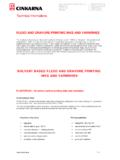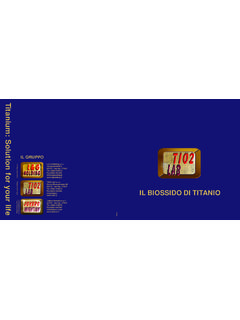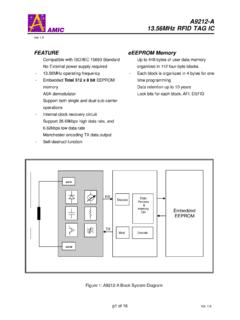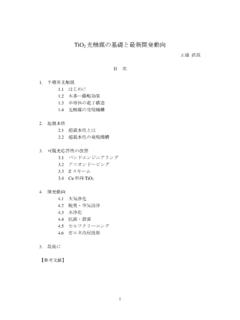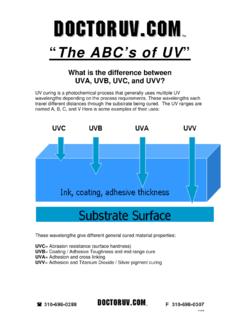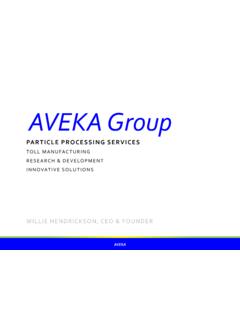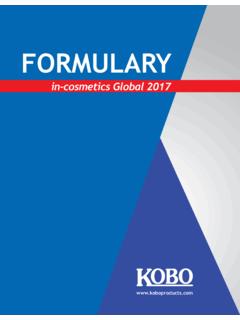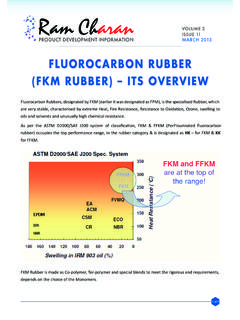Transcription of About Titanium Dioxide - Cinkarna
1 1 About Titanium Dioxide What is Titanium Dioxide ? Titanium Dioxide (TiO2) is a white solid inorganic substance that is thermally stable, non-flammable, poorly soluble, and not classified as hazardous according to the United Nations (UN) Globally Harmonized System of Classification and Labeling of Chemicals (GHS). TiO2, the oxide of the metal Titanium , occurs naturally in several kinds of rock and mineral sands. Titanium is the ninth most common element in the earth s crust. TiO2 is typically thought of as being chemically inert. What products contain TiO2? Titanium Dioxide has been used for many years (ca. 90 years) in a vast range of industrial and consumer goods including paints, coatings, adhesives, paper and paperboard, plastics and rubber, printing inks, coated fabrics and textiles, catalyst systems, ceramics, floor coverings, roofing materials, cosmetics and pharmaceuticals, water treatment agents, food colorants and in automotive products, etc.
2 What are the differences between TiO2 as a pigment and as a nanomaterial (ultrafine)? Pigment grade TiO2 is manufactured to optimise the scattering of visible light and consequently white opacity. This requires a primary particle size of approximately half the wavelength of the light to be scattered, that is half of 400 - 700nm for visible light. Titanium Dioxide Stewardship Council 2200 Pennsylvania Avenue, Suite 100W Washington, 20037 (202) 557-3800 tel. (202) 557-3836 fax Chemistry making a world of difference European Chemical Industry Council Avenue E. van Nieuwenhuyse 4 B - 1160 Brussels (Belgium) Tel: +32 2 676 73 27 Fax: +32 2 676 73 59 2 Pigment grade TiO2 is manufactured in order to maximise the number of primary particles in this size range (approx.)
3 200 350 nm). However as in all production processes of particulate materials, there will be a distribution of primary particle sizes around the average value and it is likely that a small fraction of the primary particles are < 100 nm, and therefore covered by the nanoparticle ISO definition (ISO/TC 229 Nomenclature system for nanoparticles). In practice, all these particles tend to agglomerate into the micron ( m) size range. TiO2 nanomaterials (ultrafine) are transparent and more effective as UV absorbers or photocatalysts. The transparency and UV absorbance allow for effective use as a protective ingredient for sunscreens. Due to the smaller size of primary particles and higher surface area, TiO2 as a nanomaterial allows the manufacture of various catalysts of enhanced activity.
4 TiO2 as a nanomaterial is engineered to have primary particles less than 100 nm in order to optimize such properties. TiO2 as a nanomaterial is not used as a colorant as it is functionally different from pigment size particles and will not impart color or opacity to a product. Primary particles are strongly bound or fused together by chemical bonds to form aggregates. These aggregates further agglomerate via van der Waals attractive forces to form particles in the micron ( m) size range. 3 What are the benefits derived from TiO2? As a pigment, TiO2 has excellent light-scattering properties and is used in a variety of applications that require white opacity and brightness. It absorbs UV light. When TiO2 pigment is incorporated in a polymer, it minimizes degradation of the system (embrittlement, fading and cracking).
5 Surface treating of the TiO2 can further improve this property. When used in paint or coating system, this effect ensures the longevity of the paint and the continued protection of the substrate. The use of light colored paints for interior applications provides an impression of openness and space . In addition, the high "luminosity" that comes from light colored paints reduces the energy needed to light the interior of buildings when compared to darker colors. In exterior applications the coolness conferred by TiO2 colored surfaces leads to considerable energy savings in warm and tropical area by light reflectance thus reducing the need for air-conditioning. TiO2 as a nanomaterial (ultrafine) appears transparent whilst still providing UV light absorption.
6 Surface treatments allow dispersion in different media and efficient absorption of UV energy ( in applications like sunscreens and light stabilization for wood coatings). When untreated, it can be used to decompose environmental pollutants by photocatalysis. TiO2 as a nanomaterial (ultrafine) is used for example as a DeNOx catalyst support in exhaust gas systems in cars, trucks and power plants, thus minimizing their environmental impact. 4 Are there any human health concerns with TiO2? TiO2 use is ubiquitous in our society. Most of the surfaces and items that are white in color contain TiO2. Thus, we are surrounded by TiO2 containing materials in our homes, workplaces and public areas.
7 Since the introduction of TiO2 as a commercial product in 1923, there have been no identified health concerns associated with its exposure among consumers or the general population. These facts are supported by the results from four large epidemiology studies involving more than 20,000 workers in the Titanium Dioxide manufacturing industry in North America and Europe which indicate no association with an increased risk of cancer or with any other adverse lung effects (1,2,3,4,6,10).These studies did not specifically differentiate between the ultrafine and pigmentary TiO2. In 2006, the International Agency for Research on Cancer (IARC) evaluated TiO2 as possibly carcinogenic to humans (Group 2B) based primarily on studies in rats.
8 Inhalation exposures to TiO2 in rats can result in lung effects and lung tumors. However, it is generally recognized that the rat is uniquely sensitive to the effects of lung overload which is not observed in other species including humans. (8 + TDMA IARC statement July 2011) Potential Exposure - by inhalation Workers at Titanium Dioxide manufacturing plants can be exposed to TiO2 dust. Protection measures including engineering controls and personal protective equipment are applied for exposure control and worker risk mitigation in accordance with existing regulations. Downstream users can also be exposed to TiO2 dust. Appropriate safe handling and use information are included in product documentation such as Safety Data Sheets (SDS).
9 5 Consumer exposure to TiO2 dust is presumed to be very low because TiO2 is typically incorporated into a product matrix where it is tightly bound such as in paints or plastics. Thus, inhalation exposure is not considered as relevant for the general public. - by oral intake Pigmentary TiO2 which meets appropriate purity standards is approved as a colorant for use in foods (E171 - candies, cookies, sweets, coffee whitener, toothpaste, etc ..) and pharmaceuticals (several Pharmacopoeias). - by skin contact TiO2 in pigmentary and ultrafine forms is used in cosmetics applications ( lipsticks, make-up products and sunscreens). It has been conclusively demonstrated that TiO2 is safe for use in sunscreen products to protect skin from harmful effects of solar UV radiation.
10 Comprehensive in vivo and in vitro dermal penetration studies have been performed. Studies show TiO2 particles (pigmentary or ultrafine) do not penetrate either intact or damaged skin (5, 9). Even if the skin is sunburned the penetration of TiO2 nanoparticles from representative sunscreen formulations is not enhanced (7). The former European Scientific Committee on Cosmetic Products and Non-Food Products (SCCNFP) reviewed in 2000 data on TiO2. Based on the results, SCCNFP concluded that TiO2 is safe for use in cosmetic products at a maximum concentration of 25% in order to protect the skin from certain harmful effects of UV radiation. This opinion concerns crystalline (anatase and/or rutile) Titanium Dioxide , whether or not subjected to various treatments (coating, doping, etc.)
